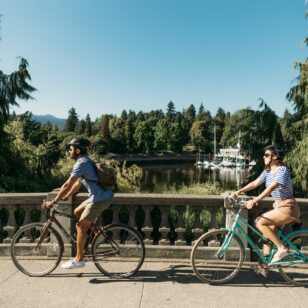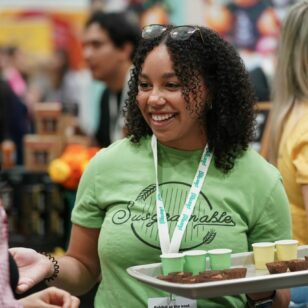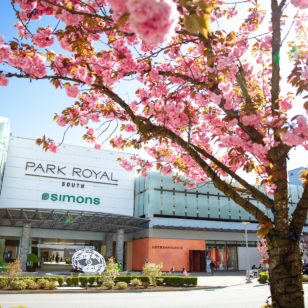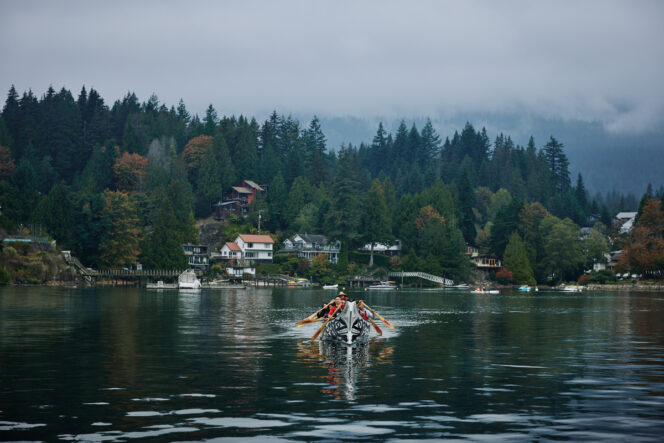
A family enjoying a guided canoe experience with Takaya Tours at Deep Cove; Destination BC/Hubert Kang
With the arrival of spring, James Healy is excited to lead tours again in a 35-foot canoe along the spectacular coastlines of Burrard Inlet. Healy, manager at Takaya Tours, is especially excited about one aspect of the tours.
“I like being out on the water. I like the feeling of the wind and the feeling of the waves beneath us,” he says. He also really likes when tour participants paddle together and fall into sync. He sees this paddling harmony as a form of naut’sa mawt, which means “one heart, one mind.”
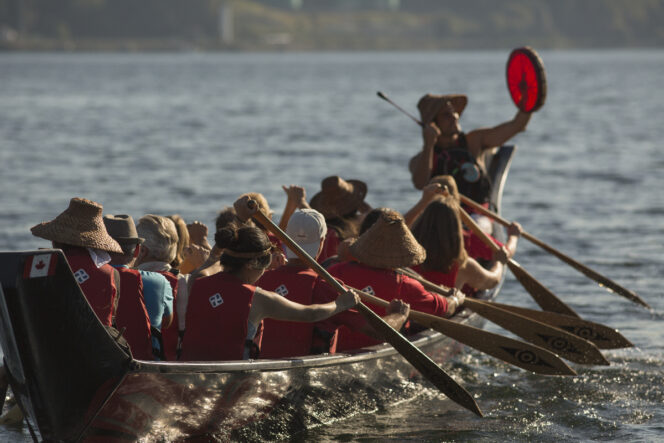
Takaya Tours First Nations Canoe Adventures on Indian Arm in North Vancouver.
Since 1999, Takaya Tours, owned and operated by the Tsleil-Waututh Nation, has been taking guests on guided paddle tours that showcase both cultural and natural expertise. Their tour season just recently launched and will run into the fall.
Currently, they are accepting bookings for two types of cultural tours: one involves interpretative paddling (minimum 10 people, 2 hour duration), and the other is a combination of canoeing and walking (minimum 30 people, 2 hour duration). They also rent kayaks, canoes, and paddle boards at təmtəmíxʷtən (Belcarra Park) and Whey-Ah-Wichen (Cates Park).
For the interpretative paddling, the experience begins in picturesque Whey-Ah-Wichen. After a traditional greeting and then safety instructions, guests embark on a journey on the waters of Burrard Inlet in canoes that are replicas of the cedar dugout ones historically used by the Tsleil-Waututh. Guests visit ancient village sites, soak up the gorgeous scenery, and listen to songs and legends.
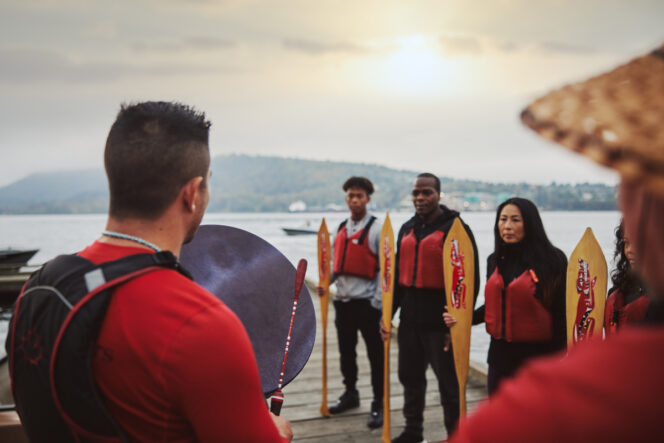
A family on a guided experience with Takaya Tours at Cates Park
Healy says that every tour is customized to the participants, as well as to the First Nations guides leading the tour. Guides will adjust the tour to the abilities of the guests; in general, there is about 10-15 minutes of gentle paddling, followed by a pause for sharing and storytelling. And each guide, based on their personal and familial experience, has something unique to talk about. “Some people are hard paddlers and they have gone on long journeys, some come from fishing backgrounds, and others have different experiences. We share a lot of the same things but everyone has their own version of the tour,” Healy says.
One legend that guides often tell involves an important hereditary leader, Waut-Salk, who had a deep connection to nature, and was able to communicate with the river and salmon. “We share his story of where he came from up in Whey-Ah-Wichen, and as the tour goes along, sometimes we will share how his life progressed and how he was laid to rest,” Healy says. As was traditional, Waut-Salk’s remains, wrapped in cedar bark, were initially placed in a tree on Boulder Island but Christian missionaries imposed their will and forced his remains to be moved from Boulder Island and buried in the ground instead.
Healy hopes guests leave the tour with a much greater sense of the cultural territories of the Tsleil-Waututh Nation. “We’re trying to share as much as we can about Tsleil-Waututh history and culture, so that people will come back to these areas with a greater respect of where they are,” Healy says. Takaya’s tours not only educate about traditional uses of the land, but they also talk about modern ways the Tsleil-Waututh steward the land, such as building new clam beds, reintroducing elk, and maintaining active fisheries.
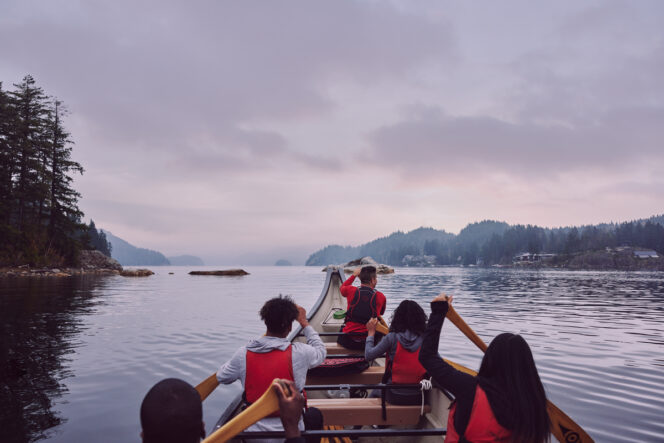
Takaya Tours at Deep Cove; Destination BC/Hubert Kang
Candace Campo, co-owner and operator of Talaysay Tours and member of the Shíshálh Nation (Sechelt), has enjoyed a lifelong love of nature that she likes to share with guests. It began with her childhood on the Sunshine Coast. “When I grew up, we were able to harvest off the land. I come from a hunting and fishing family. I grew up harvesting both berries and medicines,” she says.
One of her earlier and fondest memories involves accompanying her father at low tide to harvest seafood. “I remember being on the shoulders of my dad while he walked through the water and the eelgrass. He’d be bending over to pick up the Dungeness crab. As children, we would be playing on the mud flats and also learning how to harvest. I remember at a really young age digging cockles. It was a magical time in my life, and I feel really grateful to have grown up with these experiences,” she says.
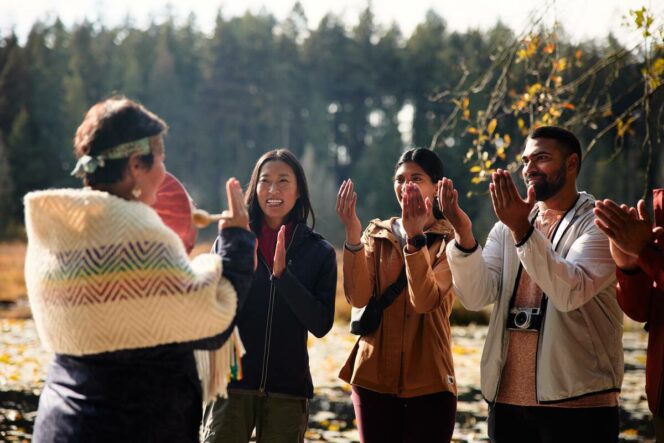
Candace Campo from Talaysay Walking Indigenous Tours is conducting a presentation and speaking to a group while on a walking experience in Stanley Park in Vancouver; Destination Vancouver/Kindred & Scout
In 2002, Campo started Talaysay Tours, combining her training in education and anthropology with her cultural knowledge. She recognized the positive impact she could make by sharing her wealth of knowledge with other people. “As a visitor, you want to meet the locals, and there’s no one more local than the Indigenous community. We have really rich heritage and a strong relationship with the land. The communities that live here come from a culture of storytelling. I feel that Indigenous experiences can provide something really unique and special to guests and visitors,” she says.
Talaysay Tours hosts a variety of tours in Stanley Park: a Forest Therapy Walk, a Spoken Treasures Tour, a Talking Totems Indigenous Art Tour, and a Talking Trees Tour. The Talking Trees Tour is very popular, and runs from now until the fall. Depending on the tour, an Indigenous cultural ambassador guide leads guests for 1.5 hours through various trails of Stanley Park and Beaver Lake areas, educating about local flora and their uses while also talking about history and culture, and telling legends and stories.
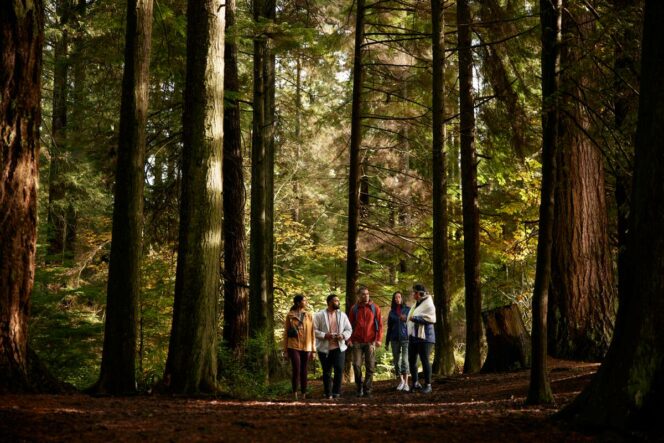
Candace Campo from Talaysay Walking Indigenous Tours is conducting a presentation and speaking to a group while on a walking experience in Stanley Park in Vancouver; Destination Vancouver/Kindred & Scout
Campo feels that trees have wisdom—it just needs to be heard. “We called it Talking Trees because, in a humble way, we understand within our world view as Indigenous people that the environment, the trees, have something to say. For us, they’re not only intelligent beings, but they’re also spirit beings,” Campo says. She adds that Western science has proven that trees are able to communicate through their root systems and are part of an intelligent ecosystem.
Like nature, the tour content shifts with the seasons and with the specific personal experiences and cultural knowledge (e.g., Squamish, Haida) of each guide. “When someone joins us, we have rich stories, we have our family histories. Our cultural ambassador guides each have expertise or knowledge in certain areas, like medicine related to food processing, or technology such as carving or toolmaking,” Campo explains.
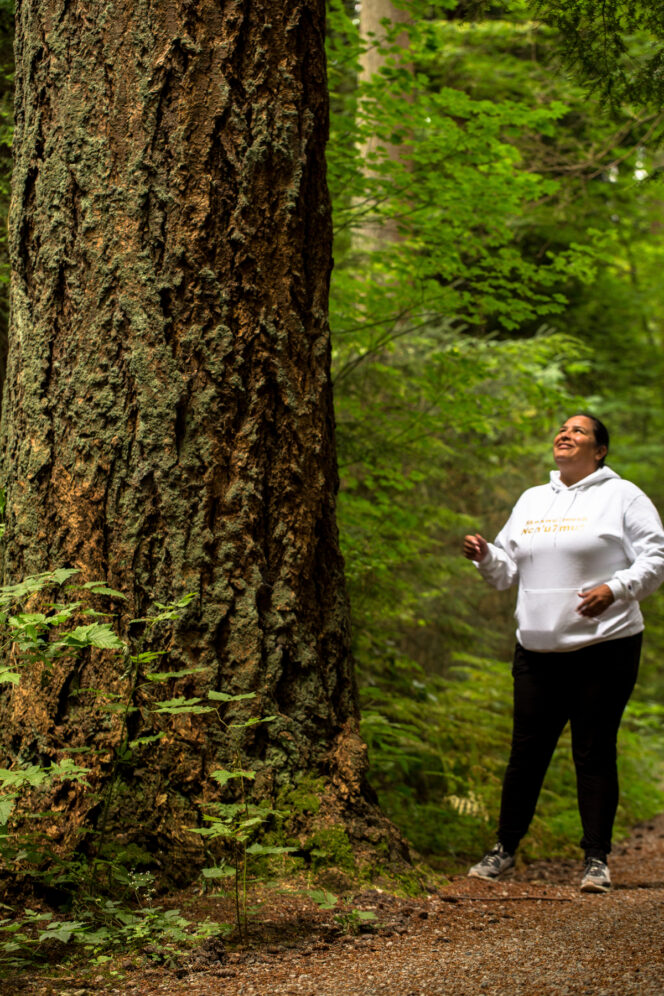
Talking Trees Tour in Stanley Park with Talaysay Tours – ITBC – Indigenous Experience
Ultimately, through the tours, Campo wants to awaken within guests a sense of respectful ecology and community. “People will have a deeper understanding of our people and the land and, hopefully, a stronger connection to the land. We feel too that we are capable of deepening people’s understanding of the complex history we hold together between Indigenous peoples and settlers,” she says.
Those interested in partaking in the Talking Trees Tour could take advantage of a package offered by the Fairmont Waterfront from now until October 30, 2022. The package features the Tour, 20% off the best available rate for their luxury accommodation, a three-course Land and Sea Feast at Salmon n’ Bannock, and a $10 donation to the Indian Residential School Survivors Society (IRSSS). Dinner consists of a beverage (beer, wine, or house-made soda), a wild salmon sampler, game charcuterie, and a choice between 24-hour braised bison roast or baked sockeye salmon.













